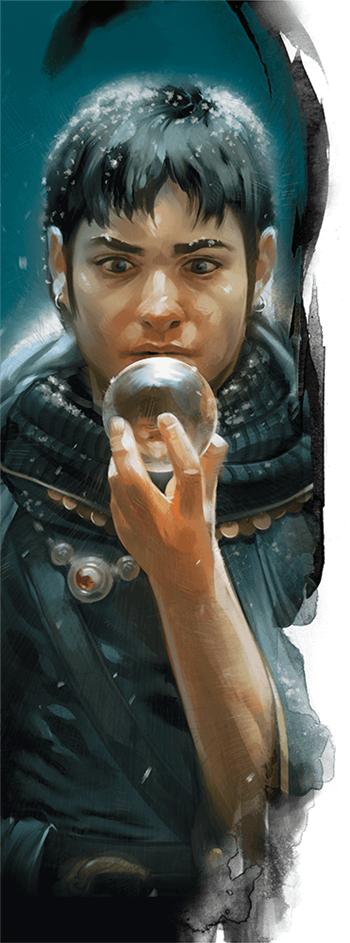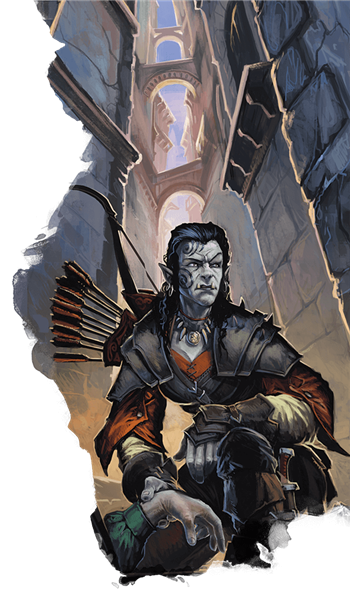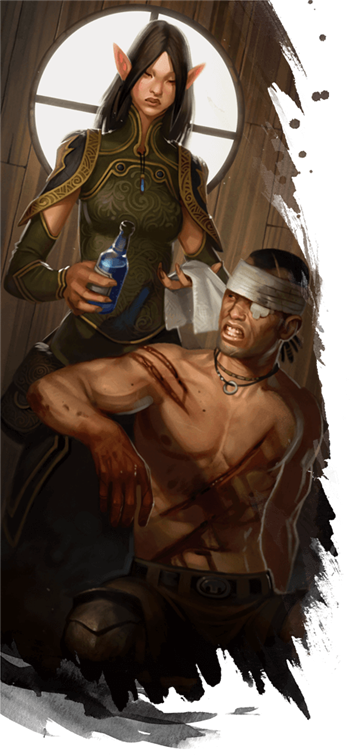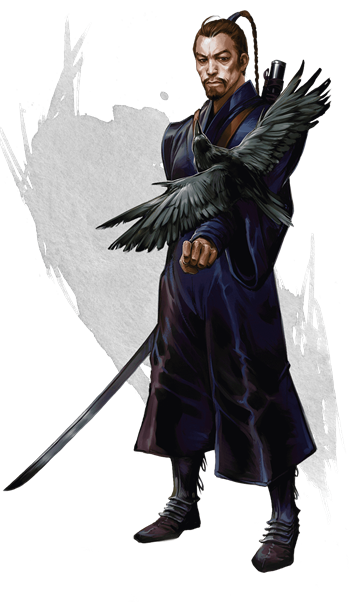 Campaigns are large sandboxes for adventurers to play in. Some DMs prefer to have more linear campaign progression, but the freedom of D&D is that you can do just about anything you want. For some players, that level of freedom brings forth a need for some stability. If that player is a DM, they can set whatever rules the table needs to achieve it. Your campaign’s world is whatever your group needs it to be. Players often react by creating extremely rich backstories for their characters as a pillar to lean on. A rogue princess with a royal curse to break; a lone barbarian who scoured the land from a young age, fighting for survival at every turn; or a prodigious mage’s assistant, finally being sent out into the world to learn and use magic as they’ve always dreamt of.
Campaigns are large sandboxes for adventurers to play in. Some DMs prefer to have more linear campaign progression, but the freedom of D&D is that you can do just about anything you want. For some players, that level of freedom brings forth a need for some stability. If that player is a DM, they can set whatever rules the table needs to achieve it. Your campaign’s world is whatever your group needs it to be. Players often react by creating extremely rich backstories for their characters as a pillar to lean on. A rogue princess with a royal curse to break; a lone barbarian who scoured the land from a young age, fighting for survival at every turn; or a prodigious mage’s assistant, finally being sent out into the world to learn and use magic as they’ve always dreamt of.
Many players are used to intricate backstories because that’s largely how many fantasy stories begin. And while that’s a completely valid way of building a character, there’s another side of (many sides of) character creation to explore. Frontstory. In my endless sea of lectures I’ve found that frontstory is best explained with the examples of the fictionally consistent, Jim Sterling inspired, Chungus and Grungus.
The Timeless Epic of Chungus and Grungus
Let’s call your adventurer with the two-page backstory, Chungus. They have, for example:
- A family lineage that includes some recent direct-family death or illness
- A personal mystery that they will allude to, but don’t plan to reveal until 12 weeks in
- One powerful childhood moment that set them on the path of becoming an adventurer
Because Chungus was built on these elements, all of the reactions they have to present events will be weighed against that backstory. That’s how our player figures out who Chungus is; using their backstory as a filter and seeing what comes out. A pitfall of this is that players keep their eyes on week 12 more so than what’s happening in front of them.
One day, Chungus’ time comes to an end. A victim of DM’s critical success and a player’s critical failure, dear Chungus perishes at a time and in a place where there’s no hope for them to continue on. We’ve lost Chungus. Gone, but never forgotten. Press F to pay respects. Chungus’ player didn’t get far enough in the campaign to reach their fulfilling reveals—and thus, all the backstory that was never revealed or never paid off is lost to the wind.
After the funeral and a hero’s sending, a new adventurer must take their place. Though Chungus’s journey is over, their player still wants to be a part of the game. And so our player has some options. They could whip out an old favorite from another campaign. They could make a brand new character who is so tied into the narrative that of COURSE they’d join the party—but our hypothetical player doesn’t have the time to write a chunky, plot hook-laden backstory this time. So instead of those options, they create Grungus.
Our player didn’t have a lot of time to write a chunky, plot hook-laden backstory for Grungus, so this new character is just a strong warrior who happens to have a horse in this narrative’s race. Since this player has little history to riff off of, they use each event as an opportunity to be a fresh eye peering into the lives of a close-knit group, just to remain relevant. To this player’s surprise this works. Not just as a way to navigate the game, but as a way to have fun. Why?
It’s because Grungus is all about what’s happening in the moment. The point of frontstory is to let go of the foundations and let the present be the beginning of your epic.
Backstory isn’t a dirty word. All good characters need motivation, and a character’s backstory can be rich with motivations. They give the player a clear path forward and a clear way to react to the things around them. Backstories are a guide on where to start before players get into the rhythm of who their characters grow into later on. Grungus, however, throws the guide out the window.
 Frontstory is about making those important bullet points that Chungus had and creating them all later, based in the events that happened in the game’s present, not its hypothetical past. The personality and development of the character is heavily weighed in when they begin to understand their party and the journey they’re undertaking. Here’s an example:
Frontstory is about making those important bullet points that Chungus had and creating them all later, based in the events that happened in the game’s present, not its hypothetical past. The personality and development of the character is heavily weighed in when they begin to understand their party and the journey they’re undertaking. Here’s an example:
In two different campaigns, Chungus and Grungus both find themselves in the same situation: collecting loot at the end of a battle. They both find out that one of the rogues that they killed had only joined this band of thieves to eventually find the assassin that killed her family. There’s a hidden diary filled with pictures and notes about her entire journey. It’s a very emotional moment for the players, but how do the characters react?
Chungus can often have their reaction tied down to the personality or experiences dictated in their history. Chungus decides that, because they’re supposed to be gruff and absent of emotion due to many past family deaths, that this assassin’s note isn’t an important development. It’s still completely possible for Chungus’ player to move their adventurer in the opposite direction, to help this deceased woman on her quest, but if backstory players aren’t careful, everything gets filtered through that dense history and passed by without a second thought.
Grungus doesn’t have any large traumas or past incidents that hold them back from assessing the character choice presented before them. Thus, whatever decision they make is based on the principles that the player is being faced with rather than being filtered. Do you want Grungus to be more empathetic? Do you want them to dash immediately into this new quest, or are they going to support whatever decision is made by the party at large? Is Grungus more hopeful than the others because they’ve seen fewer horrors? Or are they cold-hearted and focused on the main story quest? Any type of character can face these questions, but frontstory characters have each and every decision they make impacted by how much character there is to build. A character that isn’t burdened by backstory is able to act dynamically, and make the most interesting decision in the moment. Grungus is a vehicle made to learn that lesson.
The Great Reflector
There are a great many uses for characters build solely from frontstory, but one of the most useful is the ability to turn pieces of the party’s identity back at the characters. Adventures take a toll on adventurers. We receive battle scars of the body as well as the mind. The longer that this continues on, the more that people begin to become accustomed to the process of scarring. Seeing a young warrior die doesn’t carry the weight that it once did, because it can’t. To journey toward one’s final destination, the normalcy of war is an inevitability.
Grungus, as someone who can join a campaign at any point in the narrative curve, is able to look at the other characters from the perspective of one who doesn’t carry that burden. They can be a vehicle to ask some big questions like, “How have we changed from where we began?” For the group of players who enjoy some deep philosophical thinking, this question can lead to some major character development.
Not all of the reflections that Grungus brings to the table have to be loaded with heavy undertones. For more mischievous players, you can use them as a way to poke at tense romances and friendly rivalries. A brand new teammate is unknowing of the “this is complicated” energy standing between your “two ladies just bein’ pals and swinging swords”. It’s a fair question to ask what that tension is about, especially at a very tense romantic moment between the two.
Not every Grungus has to be born yesterday. Being focused on frontstory doesn’t mean that a character can’t have defining ideals or experiences. Grungus can be brand new to adventures of this scale, or they can be a seasoned warrior of even higher caliber than the character they’re replacing. The core of frontstory is to let the major details of who they are and what moves their motivations be decided in the tense moments of the present to a much larger degree than in the past.
How to Build Frontstory
 So we know what Grungus can do and how they can use their position in their social group to mix things up, but how does one make the beautiful, most amazing Grungus of legend? Well, it comes down to fundamental theming. Building as you go, which is the core of frontstory, doesn’t mean that you have no foundation from which to progress. The road you begin from can stand on a principle or idea.
So we know what Grungus can do and how they can use their position in their social group to mix things up, but how does one make the beautiful, most amazing Grungus of legend? Well, it comes down to fundamental theming. Building as you go, which is the core of frontstory, doesn’t mean that you have no foundation from which to progress. The road you begin from can stand on a principle or idea.
Most players encounter a “Grungus opportunity” when their character dies, as mentioned earlier. If the campaign has been going on for some time and you’re choosing to add a brand new hero to the story, having an illustrious backstory may solve the question as to why you arrive, but it may not give you time to explore the potential value of said story in what little time the campaign has left. A new character can connect and blend into the campaign by reflecting off of the existing narrative themes.
What are those themes? If you aren’t sure, try talking to your DM or fellow players. In heroic campaigns, these themes can include empathy, the concept of good and evil, personal loss, fear of the future, or of the past coming back to haunt a world of peace. These elements of your hero’s journey are just as valuable as making an old friend, or as pragmatic as choosing to play a non-player character. The set of skills you use to bring your adventurer into the fold are focused on what the story is about, rather than what a character might have been before the story took place. The nuance of this awareness can bring about new ways to enjoy not only D&D, but roleplaying in general.
Why Would I Grungus When I Can Chungus
 Or, why would I ever make a backstory-less character if I enjoy writing elaborate backstories? A fantastic question! Here’s another: how many times have you begun a campaign as someone who has yet to hold a sword, or who has never cast a spell? If that number is zero, then there’s an opportunity to experience something you never have before.
Or, why would I ever make a backstory-less character if I enjoy writing elaborate backstories? A fantastic question! Here’s another: how many times have you begun a campaign as someone who has yet to hold a sword, or who has never cast a spell? If that number is zero, then there’s an opportunity to experience something you never have before.
When you create a character with a dense backstory, you partially answer a great deal of questions on your own that you may wish to explore together with your party. How did I learn to fight? Who were my mentors or teachers? What difficulties arose that made me venture out into this grand world of fantasy? Sometimes a backstory is used as a way for players to set a checkmark next to these questions to signify that they’re answered rather than letting the campaign be the host for those answers.
In early editions of Dungeons and Dragons, non-player characters that don’t have stat blocks or character sheets are level 0. They don’t have skills to check or scores to modify. They are normal, everyday people. Your character was likely just like them, until one day they weren’t. You begin the journey that will one day become a story better than you could have written alone.
So if you’re from the land of backstories, try piloting a Grungus around in your next oneshot. And for those living for each moment to moment engagement, give backstory a try and see what it brings out of you as a player.
Whatever happens, new experiences help freshen up old skills. So take the leap and see what’s on the other side.
Have you ever created a character with no backstory, and whose personality developed exclusively through frontstory? Tell us about them in the comments!
 DC is an independent game designer, and the creator and author of plot ARMOR, as well as a freelance writer for Wizards of the Coast. You can find them assisting the tabletop roleplaying game community’s growth on Twitter @DungeonCommandr.
DC is an independent game designer, and the creator and author of plot ARMOR, as well as a freelance writer for Wizards of the Coast. You can find them assisting the tabletop roleplaying game community’s growth on Twitter @DungeonCommandr.








-
View User Profile
-
Send Message
Posted Aug 21, 2019Great read! Looking back, I can see that yeah, front-story leads into a really engaging and reactive playstyle for me, moreso than when I'm ever-focused on backstory and how it may or may not come into play. However, I feel that there is definitely a healthy medium between the two. If a player focuses too much on their backstory, only large, personal, and likely backstory-related events will trigger any character development, when in reality character development is happening all the time, triggered by thousands upon thousands of tiny stimuli all around us.
F for Chungus.
-
View User Profile
-
Send Message
Posted Aug 21, 2019The first character I created had no backstory except being the apprentice of a seer and running away because life in seclusion was getting too boring. Just a social awkward young adult.
During the first game sessions my lack of social competence got me into some weird, life changing situations which turned me into a schizophrenic who had to roll on whether he was himself or thought he was the incarnate of a god when doing certain stuff. Turned out pretty awesome.
-
View User Profile
-
Send Message
Posted Aug 21, 2019I now have a term for what I have been doing all along, eschewing Backstory for flexibility.
I Grungus my Frontstory.
Fantastic article, DC!
-
View User Profile
-
Send Message
Posted Aug 21, 2019Great article!
To quote one of the gone RPG elders: “Backstory is what happens in the first 3 levels.“
-
View User Profile
-
Send Message
Posted Aug 21, 2019I think this is a good read for DMs as much as it is players. As a DM, I have often begged for backstories, usually so that I can find threads within them to weave into the plot of the campaign.
I am 100% fine with players not providing any backstory as long as they are 100% okay with curveballs being thrown from my side of the screen. "As you kick the enemy soldier off of the blade of your sword, and he falls to the ground gasping, he pulls his helmet away revealing a familiar face..." (And it's probably a brother or close cousin or a childhood friend or something.)
Great article. It's something I was aware of, but hadn't had any perspective on, and I'm going to make more effort to work this way in the future.
-
View User Profile
-
Send Message
Posted Aug 21, 2019Ahhh! This is GREAT! I love this exploration of backstory vs. frontstory. Loving this series a lot! I can't wait to see what else you write!
-
View User Profile
-
Send Message
Posted Aug 21, 2019I really appreciate articles like this! Role playing is more fascinating than the rules for rolling dice.
Frontstory is much better suited to games that start at level 1. As a DM, I should focus on rewarding the frontstory decisions my characters make.
When the DM lets players pick any Backstory/backgrounds, it sometimes constricts the possible narratives in the campaign. Or, the DM feels compelled to develop an inevitable fate for the character.
-
View User Profile
-
Send Message
Posted Aug 21, 2019Sounds like lazy players making excuses for being lazy and trying to sound like they're doing something noble while doing it.
-
View User Profile
-
Send Message
Posted Aug 21, 2019Is DC going to be a regular contributor? Maybe this is the best of all possible worlds, after all.
-
View User Profile
-
Send Message
Posted Aug 21, 2019Really man? Have some respect for DC
-
View User Profile
-
Send Message
Posted Aug 21, 2019Wow!
Very well thought out. As a long time player, I’ve played Chungus and Grungus and absolutely see the effect both take on running a character and how and why choices are made during the game.
As a side note, I’m also a stage actor of 30 years and this applies to many actors as well. A backstory created with much care and love but absolutely independent of what is actually happening in the moment of rehearsal or performance. Opportunities and choices are never possible because of a predetermined story (created with love and care) that filters everything. It is a delicate balance of having context (tragic backstory) and being able to have maximum choices available to you.
Perhaps a third option to the back- and front- story is a kind of “now”story that lets you create the past in the moment. The group decides to kill the captured necromancer but the PC asks for leniency (because conflict makes for good story), when pressed for an explanation the PC creates a story of the/a necromancer providing a dignified death to a loved one suffering from an incurable disease....yadda,yadda. Perhaps not the best example, but the point is made.
Creating a past that best serves the present.
Thanks again for this great article. I’ve already shared with both my groups (all theatre people). Can’t wait to dig into the conversations.
-
View User Profile
-
Send Message
Posted Aug 21, 2019A little touchy on someone else's part? Besides at no point did I not include myself in that statement. Is not like every character I make has some detailed backstory with a bunch of plot hooks. I've played both types mentioned often.
My issue is that I recognize I'm being lazy or the game doesn't have enough time for it, or clearly is a one shot or not long term enough for a serious character. At no point is it some noble thing that makes a better character or applies anything special a character with a detailed background cannot also do if designed for it.
Too many players spend too little time on backgrounds or character details as is. No reason to encourage it or act like it's special.
Characters with real backgrounds and plot hooks are already rare as is.
-
View User Profile
-
Send Message
Posted Aug 21, 2019I think I'm more of a narrative focused DM and player than a mechanical one... sometimes that goes to far and I either plan too much in my campaigns or characters that are never relevant or are too mechanically flawed in exchange for narrative strength (let's just say I've had way more Grunguses than I have Chunguses). It's probably a good idea to set a good mechanical foundation and then build upon that with a good frontstory and light backstory rather than have a detailed backstory, lighter front story, and have the mechanics be subservient to those. I've made too many encounters that were way too easy because I couldn't figure out a way to satisfactorily introduce additional enemies into a fight and too many characters that didn't contribute because I took too many social spells and not enough combat spells for a dungeon crawl.
It's articles like these that remind me that I probably hold backstory in too high of a regard. Keep it up DC! Really liking this new series of articles.
-
View User Profile
-
Send Message
Posted Aug 21, 2019I think you're missing the whole point. This is a game to be played for fun. You might think writing an elaborate novella about what happened to your character before the game started is fun and helpful. Other people might think it's cumbersome and useless. Saying things like "Too many players spend too little time on backgrounds or character details" is a play preference. It's not a fact. It's just like, your opinion man.
Before the start of my game, I asked my players for 2 NPCs from their past and no more than 2 paragraphs about what they did before the campaign that pushed them towards adventuring. I didn't want more, because I knew I wasn't going to be able to work it all it. I also didn't ask for more because I play mostly with married people in their 30s who have kids, and I didn't want to impose upon them to give me more when I knew it wasn't going to help the game. It helps set player expectations for what I was going to try and do narratively.
This article didn't say "Don't write a backstory" but rather "if you didn't write a backstory, the game can still engage you." You call that lazy, great, I'm glad that works for you personally. But sometimes people need to be reminded this is a game and if everyone at the table having fun, you're probably playing it right no matter what the gatekeepers online might say.
-
View User Profile
-
Send Message
Posted Aug 21, 2019OK, this was a really good read, and wise as crap. I've been making Grungus characters for 30 years and really enjoy them. Can I make backstory narratives? Of course, but it is much more fun (for me) to build the character in the now, going forward.
Really well written and insightful, thank you for posting it.
-
View User Profile
-
Send Message
Posted Aug 21, 2019Every character I've ever made has had at most like a paragraph of backstory unless the DM forces me to write more, and even then it's still just a general idea. I, being an idiot, used to think this was normal, and that only crazy people wrote a two page backstory.
As it turns out, it's not normal and it excludes me from nice things like backstory tie-ins and cool magic items and powers, which, given, I suppose.
When I write that little, three to five sentence backstory, it's mainly to answer two questions: Why is this character like this (I enjoy playing, let's call them "eccentric", characters), and how did they get here, with the party?
Anyways, story tie-ins and magic powers are for losers and why yes I do quite like sour grapes.
-
View User Profile
-
Send Message
Posted Aug 21, 2019Great article. I've found sometimes myself and other players can fall into this same trap by over inflating decisions from the Suggested Characteristics options. They can be a great way to flesh out characters, but sometimes can become a trap like Chungus fell into.
-
View User Profile
-
Send Message
Posted Aug 21, 2019Most times I like to play a character with a backstory that basically eliminates the backstory my most recent character had an outburst of anger and killed everyone that was close to him which makes him have a backstory but one that can’t catch up to him.
-
View User Profile
-
Send Message
Posted Aug 21, 2019I really enjoyed reading this. Thought provoking and well written!
-
View User Profile
-
Send Message
Posted Aug 22, 2019I prefer characters with mundane backstories with a similarly-mundane, simple hook to go adventuring. I don't want to start as a hero and LVL 1. I want to start as nobody in particular and LVL 1. My characters aren't heroes... yet. The overlooked people who become heroes are my bag.
My favorite character ever comes from a puzzle-based video game—a lazy janitor with low intelligence and few useful skills who saves the galaxy several times and saves the universe a couple of times for good measure... never with the initial intention to do so. I aim for a similar target.